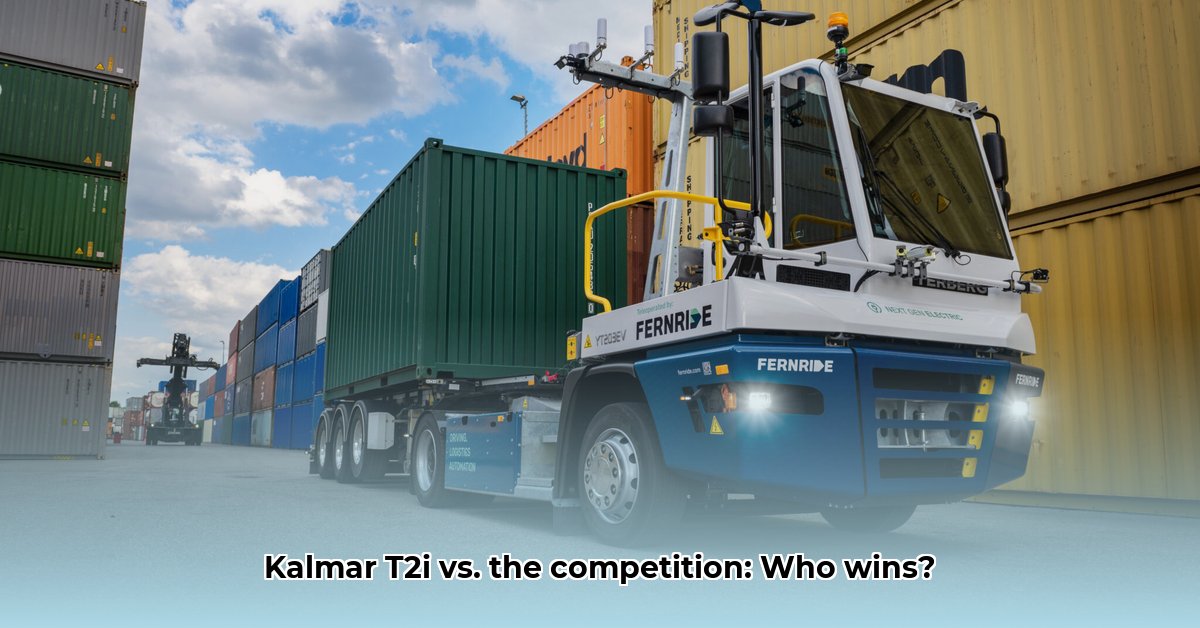
Choosing the right container tractor is crucial for efficient port operations and profitability. This comparative review analyzes the Kalmar T2i and its key competitors, focusing on factors impacting operational efficiency, total cost of ownership (TCO), and environmental impact. We'll examine fuel efficiency, driver experience, technological features, and service support to help you make an informed decision. For more on heavy equipment, see our related resources.
Key Considerations for Choosing a Container Tractor
Before diving into specific comparisons, let's outline the critical factors influencing the selection of a container tractor:
- Fuel Efficiency: Minimizing fuel consumption is paramount for reducing operating costs and environmental impact. This review will compare both fuel type and consumption rates across different models.
- Driver Experience: Operator comfort and ease of use directly impact productivity and driver retention. Features enhancing ergonomics should be carefully weighed.
- Technological Advancements: Advanced features, such as fleet management systems and predictive maintenance tools, enhance efficiency and reduce downtime. We'll analyze the capabilities and integration of such systems in various models.
- Total Cost of Ownership: A holistic view of costs, including purchase price, maintenance, repairs, fuel, and downtime, is essential for a financially sound decision.
Kalmar T2i: A Detailed Look
The Kalmar T2i is known for its focus on driver comfort and the integration of Kalmar Insight, a sophisticated fleet management system. While manufacturer claims suggest superior fuel efficiency, this requires further investigation to verify it against competing models under standardized testing conditions. The T2i's compatibility with HVO100 fuel is a significant environmental advantage, provided the readily availability and cost-effectiveness of that fuel in your operating area.
Head-to-Head Comparison: Kalmar T2i vs. Competitors (Lonestar, Hyundai, etc.)
Directly comparing the Kalmar T2i against specific competitors like Lonestar and Hyundai requires a structured approach, employing standardized testing methodologies and a thorough analysis of Total Cost of Ownership (TCO). Manufacturer claims must be approached with caution, as testing conditions and methodologies may vary considerably.
Driver Comfort and Ergonomics
The Kalmar T2i emphasizes driver comfort, designing the cab for ease of operation and reduced fatigue. However, many competitors, such as Hyundai and Lonestar, also offer models designed for operator comfort. Direct comparison requires evaluating ergonomic features such as seat adjustability, visibility, and controls’ layout via operator feedback and standardized ergonomics testing. A direct comparison of driver satisfaction metrics across different models will yield valuable insights.
Technological Features and Fleet Management
The Kalmar T2i integrates Kalmar Insight, a powerful fleet management system providing real-time operational data, predictive maintenance alerts, and remote diagnostics. While several competitors offer similar features, the specific capabilities and user-friendliness might vary. For example, some systems might offer superior predictive analytics or more robust data reporting. A critical comparison should encompass the system's ease of use, data accuracy, and the potential for integration with existing yard management systems.
Fuel Efficiency and Environmental Impact
The Kalmar T2i's compatibility with HVO100 (Hydrotreated Vegetable Oil) biofuel provides a significant environmental benefit, reducing greenhouse gas emissions compared to traditional diesel. However, the availability and cost of HVO100 must be considered within the context of your location and fuel infrastructure. The review must compare lifecycle analyses of different fuel types such as diesel, biodiesel and HVO100 for a thorough evaluation. Competitors might offer models with similar fuel efficiency or alternative sustainable fuel options.
Total Cost of Ownership (TCO) Analysis
Analyzing TCO requires a comprehensive approach that goes beyond the initial purchase price. It necessitates a detailed assessment of factors like:
- Fuel Consumption: Precise fuel consumption data under standardized operating conditions is crucial.
- Maintenance Costs: Warranty terms, service network accessibility, and parts availability are key considerations.
- Downtime: Minimizing operational interruptions through reliable equipment and efficient service support is essential.
- Driver Productivity: Operator comfort and ease of use directly impact overall productivity.
Service and Support
Reliable service and support are critical aspects of minimizing downtime and ensuring continuous operations. This comparison needs to consider the availability of service networks, response times, and the scope of warranty coverage provided by each manufacturer. Customer reviews and industry reports on service reliability can provide additional insights.
Feature Comparison Table
| Feature | Kalmar T2i | Competitors (e.g., Lonestar, Hyundai) | Notes |
|---|---|---|---|
| Driver Comfort | High priority; ergonomic design | Varies across models | Requires subjective evaluation and operator feedback |
| Technology | Kalmar Insight fleet management | Various fleet management systems available | Compare features, data analytics capabilities, and user-friendliness |
| Fuel Efficiency | HVO100 compatible; reduced emissions | Varies; some models offer alternative fuels | Evaluate lifecycle analysis of different fuels and compare fuel consumption under standardized tests. |
| Lifting Capacity | Varies depending on model | Varies across models | Specify the lifting capacities for each model being compared. |
| Service & Support | Extended warranty; consider service network | Extended warranties and service networks vary | Compare warranty terms, service network density, and response times. |
Disclaimer: Specifications and features are subject to change. Always consult the manufacturer for the most up-to-date information. This comparison is based on publicly available information and industry reports; independent verification is recommended.